Funnel-Shaped Floating Vessel Oil Skimmer with Joule Heating Sorption Functionality
Abstract
:1. Introduction
2. Materials and Methods
2.1. Materials
2.2. Sponge Fabrication
2.3. Characterization
2.4. SOS Construction
2.5. SOS Testing
3. Results and Discussion
3.1. SOS Inspiration, Design, and Functionality
3.2. Development and Characterization of Sorbent Material
3.3. Sponge Joule Heating for Viscous Oil Absorption
3.4. Oil Spill Cleanup Demonstrations
4. Conclusions
Supplementary Materials
Author Contributions
Funding
Institutional Review Board Statement
Informed Consent Statement
Data Availability Statement
Acknowledgments
Conflicts of Interest
References
- Chen, J.; Zhang, W.; Wan, Z.; Li, S.; Huang, T.; Fei, Y. Oil spills from global tankers: Status review and future governance. J. Clean. Prod. 2019, 227, 20–32. [Google Scholar] [CrossRef]
- Ferguson, A.; Solo-Gabriele, H.; Mena, K. Assessment for oil spill chemicals: Current knowledge, data gaps, and uncertainties addressing human physical health risk. Mar. Pollut. Bull. 2020, 150, 110746. [Google Scholar] [CrossRef] [PubMed]
- Ekperusi, A.O.; Onyena, A.P.; Akpudo, M.Y.; Peter, C.C.; Akpoduado, C.O.; Ekperusi, O.H. In-situ burning as an oil spill control measure and its effect on the environment. In Proceedings of the SPE Nigeria Annual International Conference and Exhibition, Lagos, Nigeria, 5–7 August 2019. [Google Scholar]
- McKinney, K.; Caplis, J.; DeVitis, D.; Van Dyke, K. Evaluation of oleophilic skimmer performance in diminishing oil slick thicknesses. In Proceedings of the International Oil Spill Conference Proceedings, 1 May 2017; pp. 1366–1381. Available online: https://meridian.allenpress.com/iosc/article/2017/1/1366/198042/EVALUATION-OF-OLEOPHILIC-SKIMMER-PERFORMANCE-IN (accessed on 25 April 2022).
- Wadsworth, T. Comparison and Assessment of Waste Generated during Oil Spills. In Proceedings of the International Oil Spill Conference Proceedings, 1 May 2014; pp. 1647–1658. Available online: https://meridian.allenpress.com/iosc/article/2014/1/1647/197951/Comparison-and-Assessment-of-Waste-Generated (accessed on 25 April 2022).
- Hadji, E.M.; Fu, B.; Abebe, A.; Bilal, H.M.; Wang, J. Sponge-based materials for oil spill cleanups: A review. Front. Chem. Sci. Eng. 2020, 14, 749–762. [Google Scholar] [CrossRef]
- Ge, J.; Zhao, H.Y.; Zhu, H.W.; Huang, J.; Shi, L.A.; Yu, S.H. Advanced sorbents for oil-spill cleanup: Recent advances and future perspectives. Adv. Mater. 2016, 28, 10459–10490. [Google Scholar] [CrossRef] [PubMed]
- Yang, Y.; Deng, Y.; Tong, Z.; Wang, C. Multifunctional foams derived from poly (melamine formaldehyde) as recyclable oil absorbents. J. Mater. Chem. A 2014, 2, 9994–9999. [Google Scholar] [CrossRef]
- Turco, A.; Malitesta, C.; Barillaro, G.; Greco, A.; Maffezzoli, A.; Mazzotta, E. A magnetic and highly reusable macroporous superhydrophobic/superoleophilic PDMS/MWNT nanocomposite for oil sorption from water. J. Mater. Chem. A 2015, 3, 17685–17696. [Google Scholar] [CrossRef]
- Gui, X.; Zeng, Z.; Lin, Z.; Gan, Q.; Xiang, R.; Zhu, Y.; Cao, A.; Tang, Z. Magnetic and highly recyclable macroporous carbon nanotubes for spilled oil sorption and separation. ACS Appl. Mater. Interfaces 2013, 5, 5845–5850. [Google Scholar] [CrossRef]
- Ge, J.; Shi, L.-A.; Wang, Y.-C.; Zhao, H.-Y.; Yao, H.-B.; Zhu, Y.-B.; Zhang, Y.; Zhu, H.-W.; Wu, H.-A.; Yu, S.-H. Joule-heated graphene-wrapped sponge enables fast clean-up of viscous crude-oil spill. Nat. Nanotechnol. 2017, 12, 434–440. [Google Scholar] [CrossRef]
- Wu, M.B.; Huang, S.; Liu, T.Y.; Wu, J.; Agarwal, S.; Greiner, A.; Xu, Z.K. Compressible Carbon Sponges from Delignified Wood for Fast Cleanup and Enhanced Recovery of Crude Oil Spills by Joule Heat and Photothermal Effect. Adv. Funct. Mater. 2020, 31, 2006806. [Google Scholar] [CrossRef]
- Wu, X.; Lei, Y.; Li, S.; Huang, J.; Teng, L.; Chen, Z.; Lai, Y. Photothermal and Joule heating-assisted thermal management sponge for efficient cleanup of highly viscous crude oil. J. Hazard. Mater. 2021, 403, 124090. [Google Scholar] [CrossRef]
- Xie, A.; Chen, Y.; Cui, J.; Lang, J.; Li, C.; Yan, Y.; Dai, J. Facile and green fabrication of superhydrophobic sponge for continuous oil/water separation from harsh environments. Colloids Surf. A Physicochem. Eng. Asp. 2019, 563, 120–129. [Google Scholar] [CrossRef]
- Xu, J.; Cao, R.; Li, M.; Chen, G.; Tian, J. Superhydrophobic and superoleophilic cuttlebone with an inherent lamellar structure for continuous and effective oil spill cleanup. Chem. Eng. J. 2020, 420, 127596. [Google Scholar] [CrossRef]
- Kong, Z.; Wang, J.; Lu, X.; Zhu, Y.; Jiang, L. In situ fastening graphene sheets into a polyurethane sponge for the highly efficient continuous cleanup of oil spills. Nano Res. 2017, 10, 1756–1766. [Google Scholar] [CrossRef]
- Chen, X.; Weibel, J.A.; Garimella, S.V. Continuous oil–water separation using polydimethylsiloxane-functionalized melamine sponge. Ind. Eng. Chem. Res. 2016, 55, 3596–3602. [Google Scholar] [CrossRef]
- Yan, C.; Ji, Z.; Ma, S.; Wang, X.; Zhou, F. 3D printing as feasible platform for on-site building oil-skimmer for oil collection from spills. Adv. Mater. Interfaces 2016, 3, 1600015. [Google Scholar] [CrossRef]
- Liu, Z.; Wang, X.; Gao, M.; Song, J.; Huang, L.; Liu, J.; Liu, X.; Xu, W.; Zhao, D. Unpowered oil absorption by a wettability sponge based oil skimmer. RSC Adv. 2016, 6, 88001–88009. [Google Scholar] [CrossRef]
- Kim, T.; Lee, J.S.; Lee, G.; Seo, D.K.; Baek, Y.; Yoon, J.; Oh, S.M.; Kang, T.J.; Lee, H.H.; Kim, Y.H. Autonomous graphene vessel for suctioning and storing liquid body of spilled oil. Sci. Rep. 2016, 6, 22339. [Google Scholar] [CrossRef] [Green Version]
- Xu, X.; Mredha, M.T.I.; Cui, J.; Vlassak, J.J.; Jeon, I. Hydrogel bowls for cleaning oil spills on water. Water Res. 2018, 145, 640–649. [Google Scholar]
- Xue, C.-H.; Li, Y.-R.; Hou, J.-L.; Zhang, L.; Ma, J.-Z.; Jia, S.-T. Self-roughened superhydrophobic coatings for continuous oil–water separation. J. Mater. Chem. A 2015, 3, 10248–10253. [Google Scholar] [CrossRef]
- Deng, D.; Prendergast, D.P.; MacFarlane, J.; Bagatin, R.; Stellacci, F.; Gschwend, P.M. Hydrophobic meshes for oil spill recovery devices. ACS Appl. Mater. Interfaces 2013, 5, 774–781. [Google Scholar] [CrossRef]
- Cheng, M.; Ju, G.; Jiang, C.; Zhang, Y.; Shi, F. Magnetically directed clean-up of underwater oil spills through a functionally integrated device. J. Mater. Chem. A 2013, 1, 13411–13416. [Google Scholar] [CrossRef]
- Choi, S.J.; Kwon, T.H.; Im, H.; Moon, D.I.; Baek, D.J.; Seol, M.L.; Duarte, J.P.; Choi, Y.K. A polydimethylsiloxane (PDMS) sponge for the selective absorption of oil from water. ACS Appl. Mater Interfaces 2011, 3, 4552–4556. [Google Scholar] [CrossRef] [PubMed]
- Tran, D.N.; Kabiri, S.; Sim, T.R.; Losic, D. Selective adsorption of oil–water mixtures using polydimethylsiloxane (PDMS)–graphene sponges. Environ. Sci. Water Res. Technol. 2015, 1, 298–305. [Google Scholar] [CrossRef]
- Rattanaumpa, T.; Naowanon, W.; Amnuaypanich, S.; Amnuaypanich, S. Polydimethylsiloxane sponges incorporated with mesoporous silica nanoparticles (PDMS/H-MSNs) and their selective solvent absorptions. Ind. Eng. Chem. Res. 2019, 58, 21142–21154. [Google Scholar] [CrossRef]
- Liu, L.; Lei, J.; Li, L.; Zhang, R.; Mi, N.; Chen, H.; Huang, D.; Li, N. A facile method to fabricate the superhydrophobic magnetic sponge for oil-water separation. Mater. Lett. 2017, 195, 66–70. [Google Scholar] [CrossRef]
- Halake, K.; Bae, S.; Lee, J.; Cho, Y.; Jo, H.; Heo, J.; Park, K.; Kim, H.; Ju, H.; Kim, Y. Strategies for Fabrication of Hydrophobic Porous Materials Based on Polydimethylsiloxane for Oil-Water Separation. Macromol. Res. 2019, 27, 109–114. [Google Scholar] [CrossRef]
- Zhang, X.; Liu, D.; Ma, Y.; Nie, J.; Sui, G. Super-hydrophobic graphene coated polyurethane (GN@ PU) sponge with great oil-water separation performance. Appl. Surf. Sci. 2017, 422, 116–124. [Google Scholar] [CrossRef]
- Bentini, R.; Pola, A.; Rizzi, L.G.; Athanassiou, A.; Fragouli, D. A highly porous solvent free PVDF/expanded graphite foam for oil/water separation. Chem. Eng. J. 2019, 372, 1174–1182. [Google Scholar] [CrossRef]
- Zhang, A.; Chen, M.; Du, C.; Guo, H.; Bai, H.; Li, L. Poly(dimethylsiloxane) oil absorbent with a three-dimensionally interconnected porous structure and swellable skeleton. ACS Appl Mater. Interfaces 2013, 5, 10201–10206. [Google Scholar] [CrossRef]
- Zhang, L.; Zhang, Y.; Chen, P.; Du, W.; Feng, X.; Liu, B.F. Paraffin Oil Based Soft-Template Approach to Fabricate Reusable Porous PDMS Sponge for Effective Oil/Water Separation. Langmuir 2019, 35, 11123–11131. [Google Scholar] [CrossRef]
- Singh, S.; Jelinek, R. Solar-mediated oil-spill cleanup by a carbon dot-polyurethane sponge. Carbon 2020, 160, 196–203. [Google Scholar] [CrossRef]
- Guo, Z.; Long, B.; Gao, S.; Luo, J.; Wang, L.; Huang, X.; Wang, D.; Xue, H.; Gao, J. Carbon nanofiber based superhydrophobic foam composite for high performance oil/water separation. J. Hazard. Mater. 2021, 402, 123838. [Google Scholar] [CrossRef] [PubMed]
- Nguyen, D.D.; Tai, N.-H.; Lee, S.-B.; Kuo, W.-S. Superhydrophobic and superoleophilic properties of graphene-based sponges fabricated using a facile dip coating method. Energy Environ. Sci. 2012, 5, 7908–7912. [Google Scholar] [CrossRef]
- Chang, J.; Shi, Y.; Wu, M.; Li, R.; Shi, L.; Jin, Y.; Qing, W.; Tang, C.; Wang, P. Solar-assisted fast cleanup of heavy oil spills using a photothermal sponge. J. Mater. Chem. A 2018, 6, 9192–9199. [Google Scholar] [CrossRef] [Green Version]
- Gong, C.; Lao, J.; Wang, B.; Li, X.; Li, G.; Gao, J.; Wan, Y.; Sun, X.; Guo, R.; Luo, J. Fast and all-weather cleanup of viscous crude-oil spills with Ti 3 C 2 TX MXene wrapped sponge. J. Mater. Chem. A 2020, 8, 20162–20167. [Google Scholar] [CrossRef]
- Phanthong, P.; Reubroycharoen, P.; Kongparakul, S.; Samart, C.; Wang, Z.; Hao, X.; Abudula, A.; Guan, G. Fabrication and evaluation of nanocellulose sponge for oil/water separation. Carbohydr. Polym. 2018, 190, 184–189. [Google Scholar] [CrossRef]
- Guselnikova, O.; Barras, A.; Addad, A.; Sviridova, E.; Szunerits, S.; Postnikov, P.; Boukherroub, R. Magnetic polyurethane sponge for efficient oil adsorption and separation of oil from oil-in-water emulsions. Sep. Purif. Technol. 2020, 240, 116627. [Google Scholar] [CrossRef]
- Peng, L.; Yuan, S.; Yan, G.; Yu, P.; Luo, Y. Hydrophobic sponge for spilled oil absorption. J. Appl. Polym. Sci. 2014, 131. [Google Scholar] [CrossRef]
- Liu, Y.; Ma, J.; Wu, T.; Wang, X.; Huang, G.; Liu, Y.; Qiu, H.; Li, Y.; Wang, W.; Gao, J. Cost-effective reduced graphene oxide-coated polyurethane sponge as a highly efficient and reusable oil-absorbent. ACS Appl. Mater. Interfaces 2013, 5, 10018–10026. [Google Scholar] [CrossRef]
- Meyer, P.; Schmidt, W.; Delgado, J.-E.; Devitis, D.; Haugstad, E.; Potter, S.; Crickard, M. Application of the American Society of Testing and Materials’ (ASTM) New Skimmer Test Protocol. 2009. Available online: http://citeseerx.ist.psu.edu/viewdoc/summary?doi=10.1.1.621.535 (accessed on 25 April 2022).
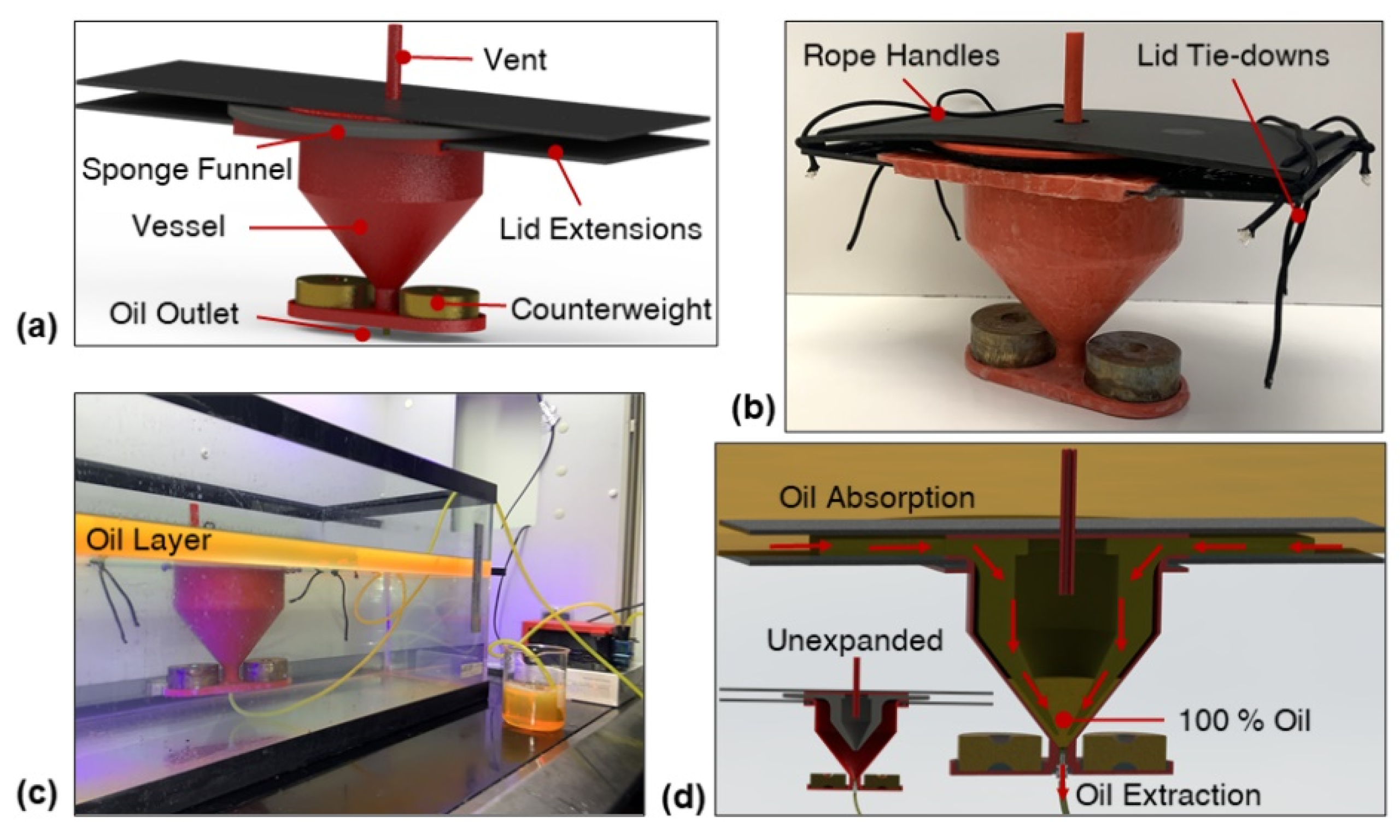




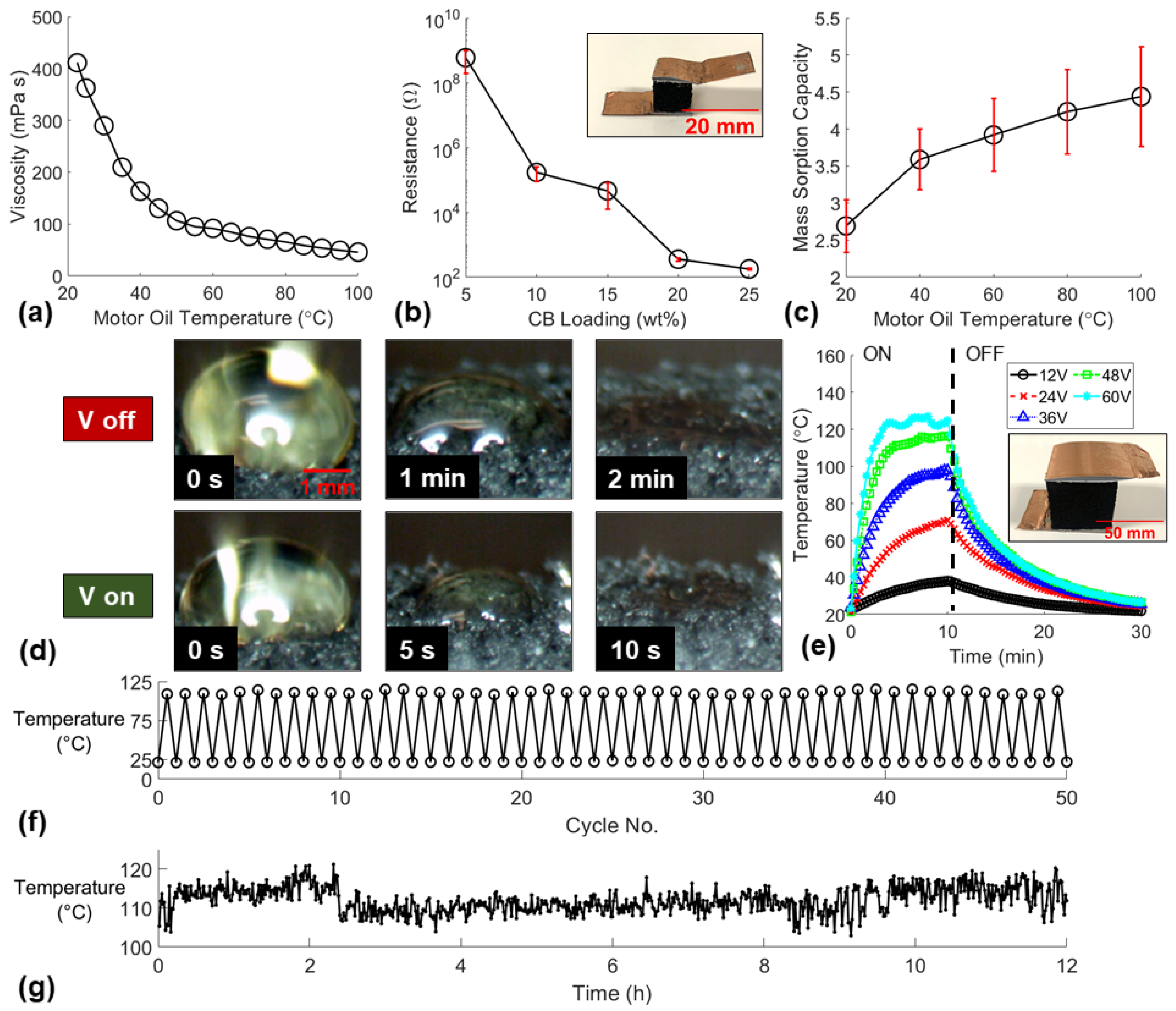
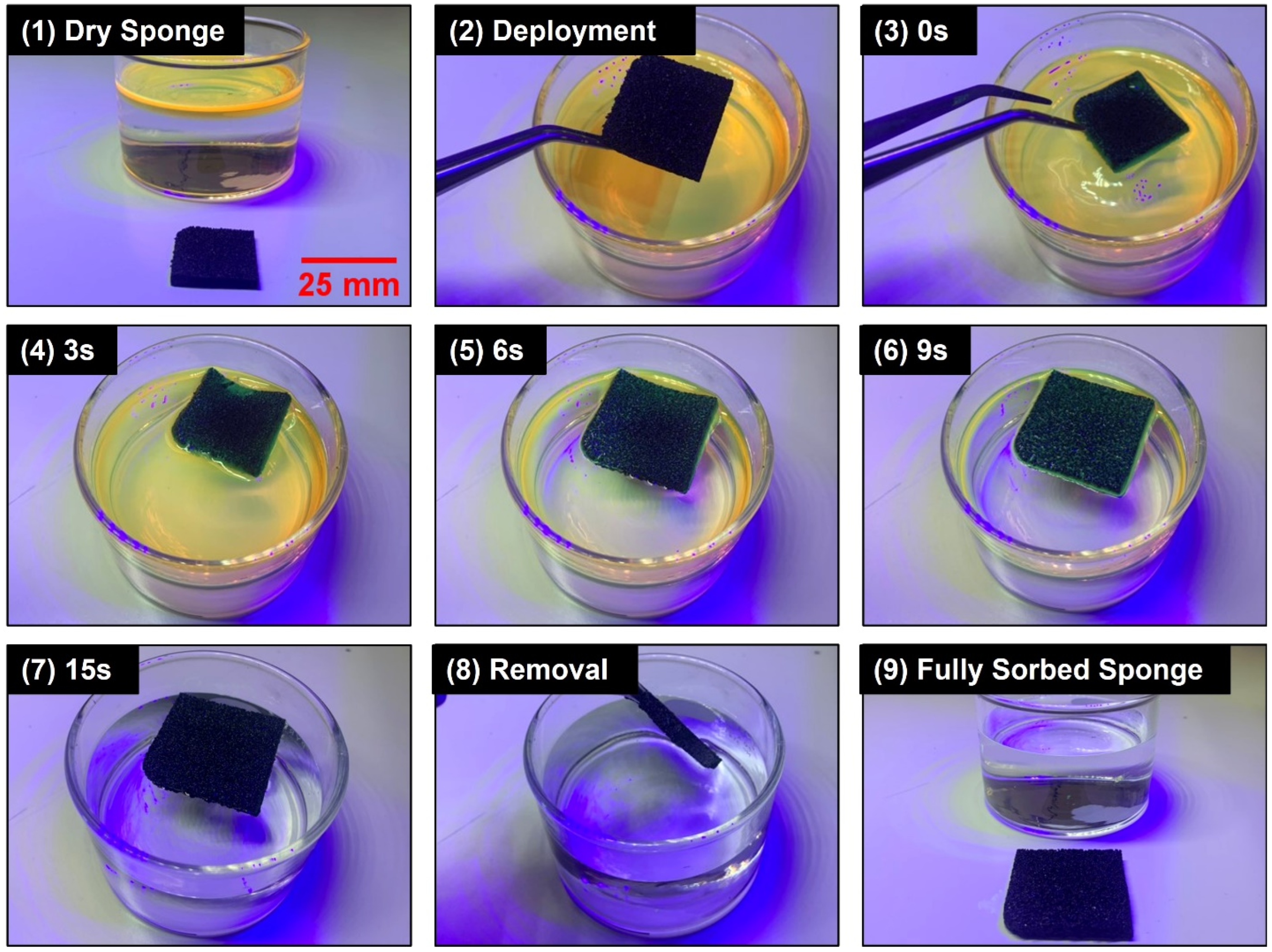
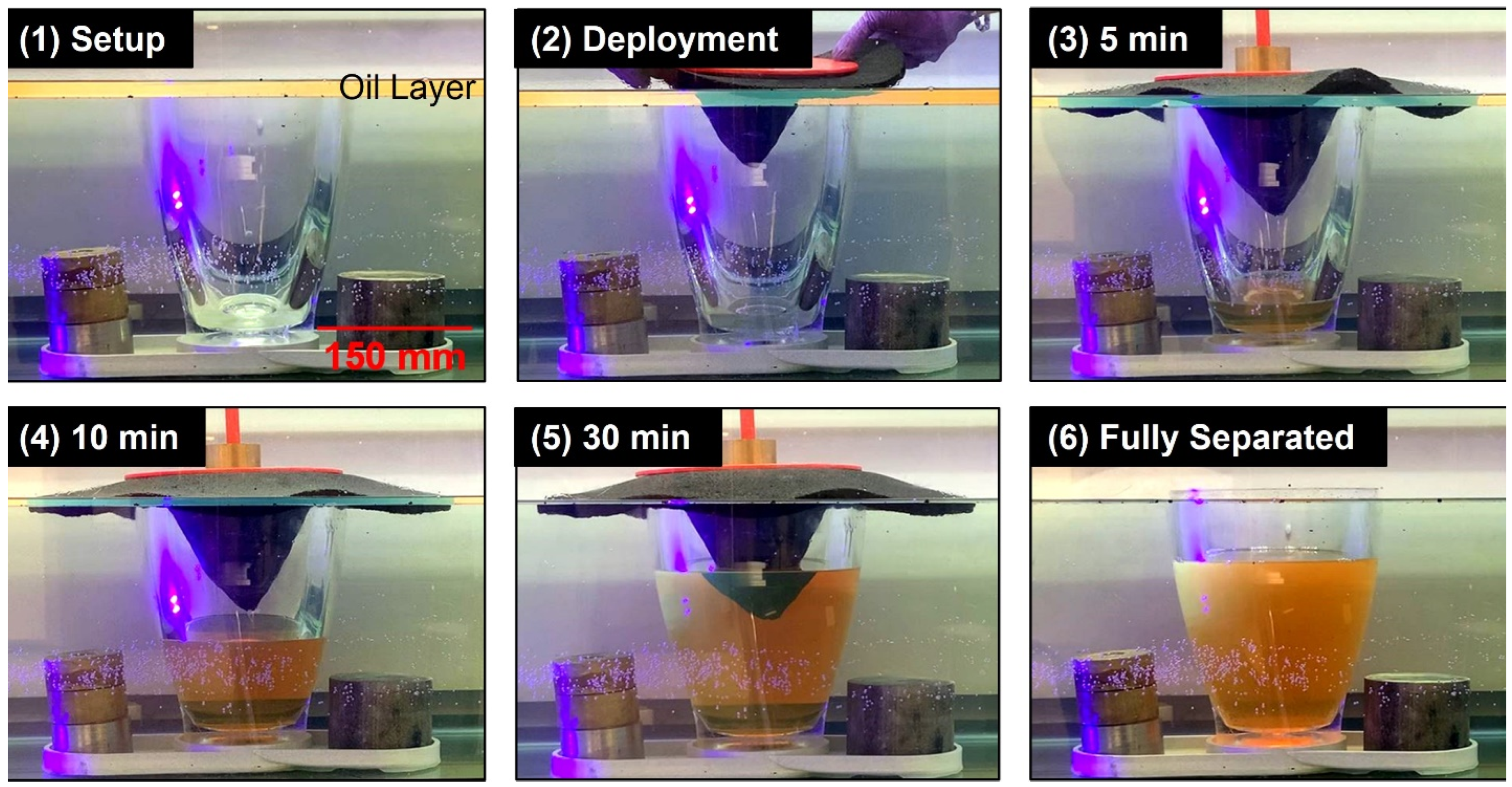
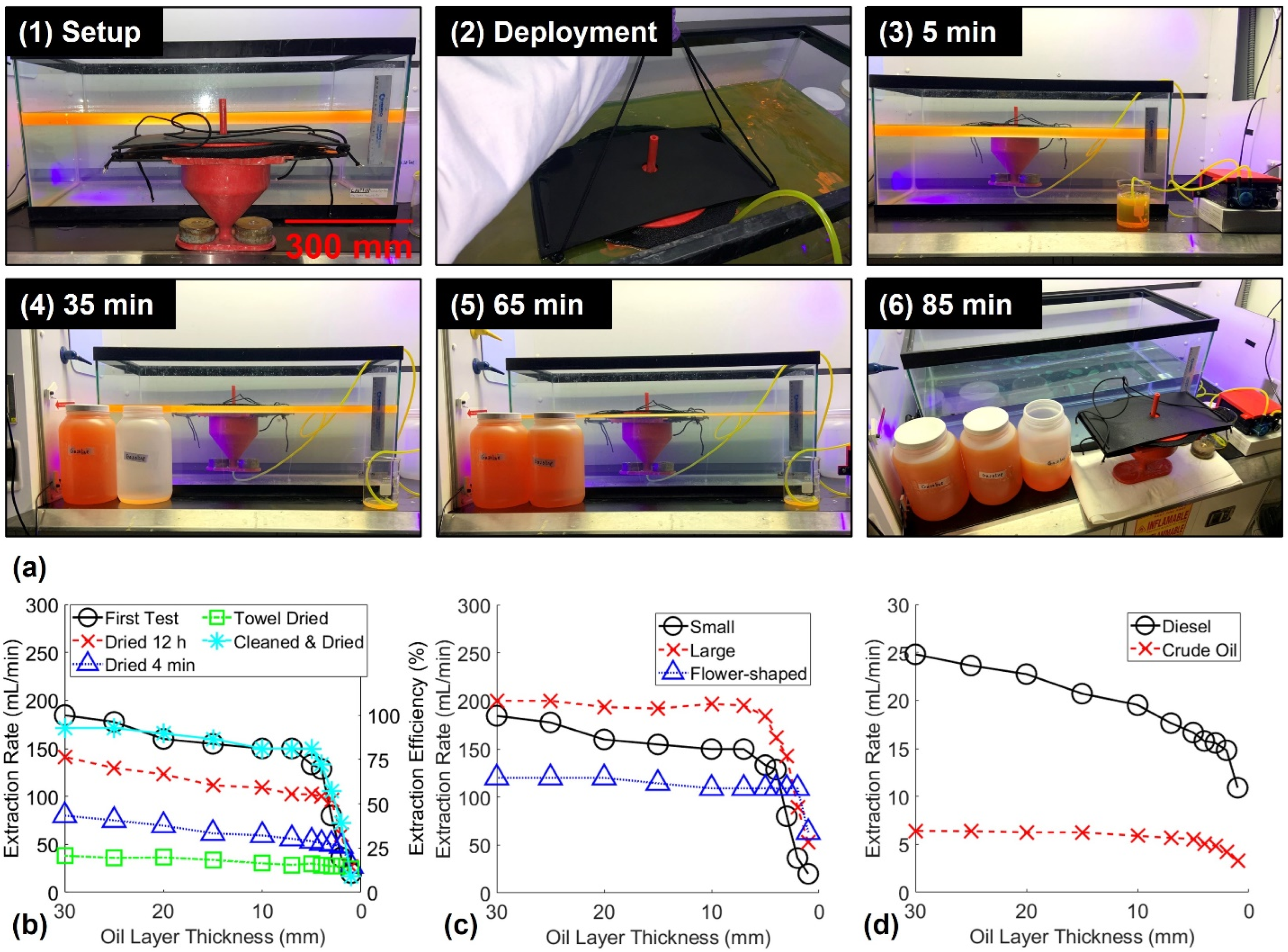
Publisher’s Note: MDPI stays neutral with regard to jurisdictional claims in published maps and institutional affiliations. |
© 2022 by the authors. Licensee MDPI, Basel, Switzerland. This article is an open access article distributed under the terms and conditions of the Creative Commons Attribution (CC BY) license (https://creativecommons.org/licenses/by/4.0/).
Share and Cite
Herren, B.; Saha, M.C.; Altan, M.C.; Liu, Y. Funnel-Shaped Floating Vessel Oil Skimmer with Joule Heating Sorption Functionality. Polymers 2022, 14, 2269. https://doi.org/10.3390/polym14112269
Herren B, Saha MC, Altan MC, Liu Y. Funnel-Shaped Floating Vessel Oil Skimmer with Joule Heating Sorption Functionality. Polymers. 2022; 14(11):2269. https://doi.org/10.3390/polym14112269
Chicago/Turabian StyleHerren, Blake, Mrinal C. Saha, M. Cengiz Altan, and Yingtao Liu. 2022. "Funnel-Shaped Floating Vessel Oil Skimmer with Joule Heating Sorption Functionality" Polymers 14, no. 11: 2269. https://doi.org/10.3390/polym14112269
APA StyleHerren, B., Saha, M. C., Altan, M. C., & Liu, Y. (2022). Funnel-Shaped Floating Vessel Oil Skimmer with Joule Heating Sorption Functionality. Polymers, 14(11), 2269. https://doi.org/10.3390/polym14112269







